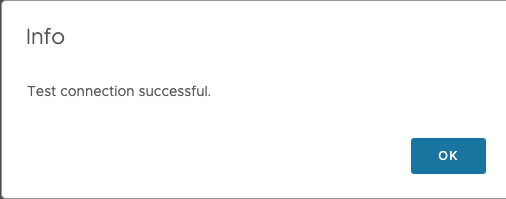Prerequisites
Procedure
- Log in to VMware Aria Operations (SaaS)
- Expand Data Sources on the left pane and open the Integrations page
- Select "Add Account"
- Select "VMware Aria Operations for Applications"
- Enter a Name and (optionally) a description for this account.
- Enter the Aria Operations for Applications URL. For example, https://vmware.wavefront.com/.
- Click the + button to add a Credential.
- Provide a Credential Name and enter your token. See Creating a Token in VMware Aria Operations for Applications.
- Click OK.
- For Collector / Group, select a cloud proxy. Ensure the selected cloud proxy has outbound network access to make HTTPS requests to VMware Aria Operations for Applications' API.
- (Optional) Under Advanced Settings, set the VMware Aria Operations URL to match your VMware Aria Operations (SaaS) environment. The value should be set to everything in the VMware Aria Operations URL before '/ui/'.
- (Optional) Under Advanced Settings, modify the Custom Metric Prefixes. The default metric prefix is 'kubernetes' (e.g., kubernetes.cluster.cpu.usage_rate). Most users should leave this field with the default value. Sometimes the Kubernetes Integration has been configured with one or more custom metric prefixes. If so, you may specify those prefixes in a comma-separated list.
NOTE: Custom metric prefixes other than 'kubernetes' are not supported by the default dashboards that are delivered with the Kubernetes Integration for VMware Aria Operations for Applications.
- (Optional) Under Advanced Settings, you can choose whether to enable Pod collection. The default is True. If you choose False, Pod objects will not be collected, nor will Pod metrics on Namespace objects.
For large, highly active Kubernetes environments, it may be necessary to turn off Pod collection. Use this setting or Pod Retention Time to ensure your total object count does not exceed the recommended limit according the the VMware Aria Operations sizing guide.
- (Optional) Under Advanced Settings, modify the Pod Retention Time in Hours. This field tells the adapter how long to retain Pod objects with a status of Not Existing or None.
NOTE: Kubernetes clusters may have a large number of ephemeral pods. Short-lived Pods objects will be created initially, then moved to Not Existing and/or None status after they have been terminated. Watch the number of Pod objects to ensure the total object count does not exceed maximum the recommended in the VMware Aria Operations sizing guide. Reduce the Pod Retention Time as needed to stay within the recommended limits.
- (Optional) Under Advanced Settings, specify the Query Timeout. This field determines how long to wait for API responses from VMware Aria Operations for Applications. The default (30 seconds) should suffice for most environments. If you have missing or intermittent data, try increasing the timeout up to 300 seconds (5 minutes). Increasing the timeout beyond 300 seconds will have no effect, because the default server timeout is 5 minutes.
- (Optional) Under Advanced Settings, you can choose whether to enable External Links. By default (True), the adapter will create and manage external links in VMware Aria Operations for Applications. These external links can be used to navigate from VMware Aria Operations for Applications dashboards to the VMware Aria Operations Troubleshooting Workbench.
NOTE: Only one adapter instance should be configured to manage external links for a given instance of VMware Aria Operations for Applications.
- (Optional) Under Advanced Settings, modify the Adapter Memory Limit. This should only be used if this cloud account has been shown to have memory issues.
- Select Validate Connection. This may take up to 60 seconds. Accept the certificate if prompted. If everything works, it will say "Test connection successful." Otherwise, see Troubleshooting Common Errors to diagnose and resolve the problem.

- Once you see Test connection successful, it's time to save the cloud account. Select the "Add" button at the bottom of the page. Your account is saved and should be visible on the Accounts tab under VMware Aria Operations for Applications.

What to do next
At first your account will have a yellow Warning status. After 5-10 minutes, the status should update to a green OK. If not, see Troubleshooting Common Errors to diagnose and resolve the problem.